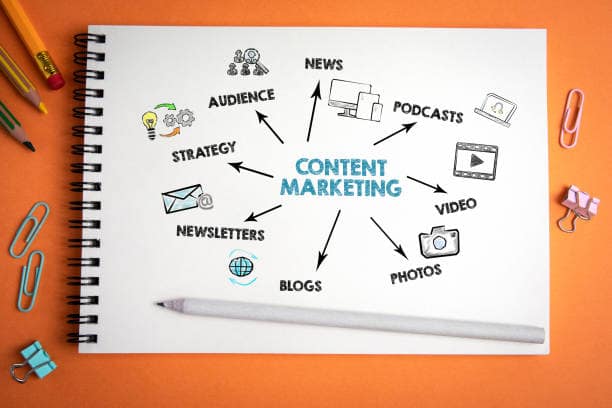
Introduction
In today’s digital-first world, where attention spans are shorter than ever and traditional advertising feels intrusive, content marketing has emerged as one of the most effective ways to build brand awareness, engage audiences, and drive business growth. Unlike direct advertising that pushes products or services onto consumers, content marketing focuses on delivering valuable, relevant, and consistent content to attract and retain a clearly defined audience.
This blog will explore everything you need to know about content marketing—what it is, why it matters, the different types, strategies to succeed, and the trends shaping its future. By the end, you’ll have a complete roadmap to harnessing the power of content marketing for your business or personal brand.
What is Content Marketing?
Content marketing is a strategic approach to creating and distributing valuable, relevant, and consistent content to attract and retain a specific audience—and ultimately drive profitable customer action.
Unlike traditional marketing, which often disrupts audiences with ads, content marketing earns attention by providing solutions, information, or entertainment. It is about building trust, not forcing a sale.
Key Principles of Content Marketing:
- Value-driven: The content must solve a problem or provide insights.
- Consistency: Regular publishing builds credibility and trust.
- Audience-focused: Tailored to the needs, interests, and pain points of the target audience.
- Goal-oriented: Every piece of content should align with larger business objectives.
Why Content Marketing Matters in the Digital Era
1. Builds Trust and Authority
Modern consumers are skeptical of hard-sell tactics. By consistently providing valuable information, businesses can position themselves as trusted experts in their industries.
2. Improves Search Engine Visibility
Google rewards high-quality content with better rankings. A well-executed content marketing strategy boosts organic traffic.
3. Generates Quality Leads
Educational or engaging content attracts people already interested in your niche, improving lead quality compared to generic advertising.
4. Cost-Effective Compared to Traditional Advertising
According to Demand Metric, content marketing costs 62% less than traditional marketing and generates 3x as many leads.
5. Strengthens Customer Relationships
Content builds long-term relationships rather than one-time transactions. Engaged audiences often turn into loyal customers.
Types of Content Marketing
Content marketing is versatile and can take many forms depending on your audience, platform, and goals.
1. Blog Posts
Blogs remain the backbone of content marketing. They are excellent for SEO, brand authority, and education.
2. Videos
Video content dominates social media and has higher engagement rates. Tutorials, product demos, and brand stories work particularly well.
3. Infographics
Visually appealing and easy to digest, infographics are great for simplifying complex information.
4. Podcasts
Podcasts provide an intimate way to engage audiences, especially professionals who consume content while multitasking.
5. E-books and Whitepapers
These long-form formats help capture leads through gated downloads, making them ideal for B2B marketing.
6. Case Studies
Case studies highlight real-life success stories and provide social proof for potential customers.
7. Social Media Content
Platforms like Instagram, LinkedIn, and TikTok enable brands to share bite-sized, engaging content for awareness and community building.
8. Email Newsletters
Email remains a powerful channel for nurturing leads and maintaining regular communication with your audience.
The Content Marketing Strategy Framework
A successful content marketing strategy requires careful planning. Here’s a step-by-step breakdown:
Step 1: Define Your Goals
Do you want to increase brand awareness, drive website traffic, generate leads, or improve customer loyalty? Your goals determine your approach.
Step 2: Identify Your Target Audience
Create buyer personas that include demographics, pain points, motivations, and online behavior.
Step 3: Choose Content Types and Channels
Not all formats work for all audiences. Select channels where your audience spends the most time.
Step 4: Create a Content Calendar
Consistency is key. A content calendar ensures timely delivery and a balanced mix of topics.
Step 5: Optimize for SEO
Use keyword research tools to align content with search intent and maximize visibility.
Step 6: Promote Content
Distribution is as important as creation. Leverage social media, email, influencer collaborations, and paid ads.
Step 7: Measure and Adjust
Track performance using KPIs like traffic, engagement, leads, and conversions. Refine based on data.
Content Creation: Best Practices
1. Focus on Storytelling
Stories connect emotionally with audiences, making your brand more relatable.
2. Prioritize Quality Over Quantity
One great blog post is better than five mediocre ones. Quality builds trust and engagement.
3. Write for Humans First, SEO Second
Search engines prioritize user-friendly content. Avoid keyword stuffing and focus on value.
4. Repurpose Content
Turn a blog post into an infographic, a video into social media snippets, or a podcast into a blog summary.
5. Use Engaging Visuals
Images, graphics, and videos break up text and improve readability.
SEO and Content Marketing: A Perfect Match
Search Engine Optimization (SEO) and content marketing are inseparable. Content fuels SEO, and SEO ensures your content gets discovered.
Key SEO Tactics for Content Marketing:
- Keyword research for targeting relevant queries.
- On-page optimization (titles, meta descriptions, headers).
- Building backlinks for authority.
- Technical SEO (site speed, mobile-friendliness).
- Updating old content for relevance.
Content Distribution & Promotion
Creating content is only half the battle; distributing it effectively is crucial.
Organic Promotion
- Social media shares
- SEO-driven blog traffic
- Community engagement (forums, groups)
Paid Promotion
- Social media ads
- Google Ads for content campaigns
- Sponsored placements
Influencer and Partner Collaborations
Partnering with influencers or other brands amplifies reach and credibility.
Measuring Content Marketing Success
Tracking metrics ensures your efforts are paying off.
Key Metrics to Track:
- Traffic: Page views, unique visitors.
- Engagement: Time on page, shares, comments.
- Leads: Form submissions, downloads.
- Conversions: Sales or desired actions taken.
- ROI: Revenue compared to costs.
Tools like Google Analytics, SEMrush, and HubSpot help track these metrics.
Common Mistakes to Avoid
- Lack of strategy: Publishing without goals or direction.
- Inconsistency: Irregular posting leads to audience drop-off.
- Neglecting SEO: Great content without optimization won’t get discovered.
- Over-promotion: Too much self-promotion turns off readers.
- Ignoring analytics: Without data, you can’t improve.

Future Trends in Content Marketing
1. AI-Driven Content Creation
Artificial intelligence is transforming how content is ideated, created, and optimized.
2. Short-Form Video Domination
Platforms like TikTok, Instagram Reels, and YouTube Shorts will continue to grow.
3. Voice Search Optimization
With smart speakers on the rise, optimizing for voice queries will become essential.
4. Interactive Content
Quizzes, polls, and AR/VR experiences will drive deeper engagement.
5. Personalization at Scale
Brands will use data to deliver hyper-personalized content experiences.
Conclusion
Content marketing is not a quick-fix strategy but a long-term investment in building trust, authority, and meaningful customer relationships. Whether you are a startup, a personal brand, or an established company, creating valuable and consistent content is the key to standing out in today’s crowded digital landscape.
By understanding your audience, delivering high-quality content, optimizing for SEO, and promoting strategically, you can unlock the true potential of content marketing. And as the digital world continues to evolve, staying adaptable and creative will ensure your brand remains relevant and influential.
Follow us on Instagram @formandfly_27
Check out our Blog on How Analytics Can Fuel Your Marketing Success



